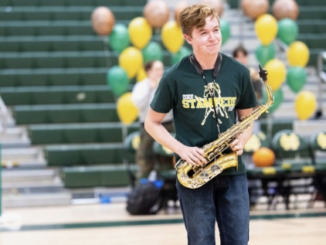
By Elizabeth Goldman
Editor-in-Cheif
For the 2022-23 school year, Costa updated its armed intruder lockdown procedure to the “Run, Hide, Fight” or “Run, Hide, Defend” model, a newer strategy becoming more widely accepted by police agencies and school districts across the nation.
Students were shown a video during third period on Sept. 29 about the revised procedures that featured School Resource Officer Donovan Torres and Interim Vice Principal Dr. Carolyn
Seaton. The previous model consisted of an administrator announcing the lockdown or cuing an emergency bell over the PA system followed by students and teachers immediately locking and barricading doors, drawing blinds, hiding in a corner, turning lights off, and staying quiet.
“[The] Columbine [shooting] in 1999 really shifted, not only police response procedures, but also school response procedures as it relates to armed intruders and active shooters,” said Torres. “Everything following that was pretty much an administrator [saying], ‘lockdown, lockdown, lockdown,’ and everyone focus[ing] on [quietly and quickly] getting into a locked and enclosed area.”
More recently, schools across the nation have begun to adopt the “Run, Hide, Fight” model, where students and teachers are instructed to independently assess the situation and determine the safest course of action, with running prioritized, according to Torres. The “Run, Hide, Fight” model applies to all scenarios with an intruder on campus wielding any type of weapon with the intent to do harm.
“After so many unfortunately tragic incidents and a lot of failed response plans, we feel that lockdown simply isn’t enough,” said Torres. “[Our response plan] needs to be a lot more fluid, [and] it needs to give the opportunity for people to have options. Given the totality of everything that’s going on and all of the information that you can ascertain, you have to make the determination of what your best chance for survival is.”
If an armed intruder enters the school, students are encouraged to run off campus if they feel safe to do so. In the video presented to students, a few courses and destinations were suggested, including running northbound on Peck Avenue or Meadows Avenue toward Polliwog Park or Manhattan Heights Athletic Facilities.
“The inherent downside is the complexity of knowing what to do in the moment, because …it’s truly a lot for any human to have to decide, but instincts kick in, and fight or flight [mode] kicks in, so to have the option to pick flight is an important one,” said English teacher Diana Sieker. “I’m glad that I have that autonomy to read the situation and determine the best course of action to keep as many people as safe as possible.”
According to Torres, if running is not an option, hiding is the next best course of action. If the attacker breaches the barricaded door and enters the classroom, students and teachers should be ready to defend themselves and fight the intruder.
“When running is not a feasible option, then hiding is best, [which] is going to look very familiar to the old lockdown method,” said Torres. “Lastly would be the fight portion, the nitty-gritty, no rules type of fight– the fight for survival– so you’re doing whatever you can, using improvised weapons and having a plan and executing it.”
Following the 13-minute video shown on Sept. 29 to students, teachers facilitated conversations with their students to formulate a safety plan for their classroom and clarified any concerns students may have. According to junior Kate Christensen, it is helpful for students to have access to more specific information in an emergency situation, as long as students remember to stay calm and not panic.
“[Having the option to run] does make me feel safer because it’s good knowing that we have other options in case some of them don’t work out,” said Christensen. “I know in some cases we wouldn’t be able to simply hide or simply defend, so having other options helps us know that the school is prepared for these types of situations.”




Leave a Reply